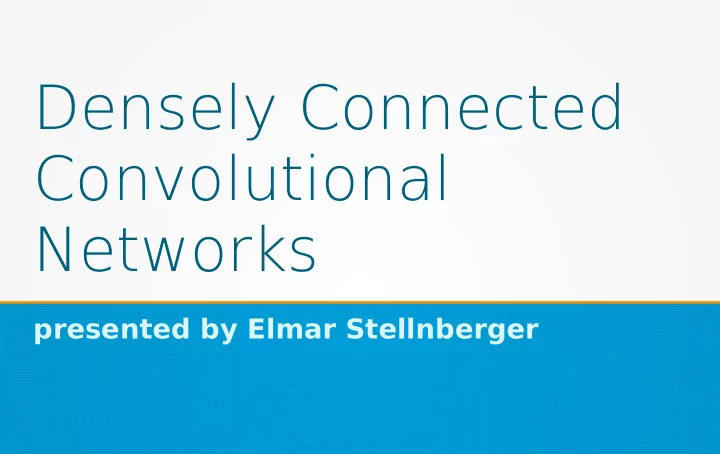

Densely Connected Convolutional Networks presented by Elmar Stellnberger
a 5-layer dense block, k=4
Densely Connected CNNs ● better feature propagation & feature reuse ● alleviate the vanishing gradient problem ● parameter-effjcient ● less prone to overfjtting even without data augmentation ● naturally scale to hundreds of layers yielding a consistent improvement in accuracy
DenseNet Architecture ● Traditional CNNs: x l = H l (x l-1 ) ● ResNets: x l = H l (x l-1 ) + x l-1 ● DenseNets: x l = H l ([x 0 ,x 1 ,.., …,x l-2 ,x l-1 ]) ● H l (x) in DenseNets ~ Batch Normalization (BN), rectifjed linear units (ReLU), 3x3 Convolution ● k 0 + k·(l-1) input activation maps for layer l but: data reduction required, f.i. by max-pooling with stride ⩾ 2
DenseNet Architecture ● only dense blocks are fully connected ● between dense blocks: convolution & 2x2 average pooling → transition layers
DenseNet Variants ● DenseNet-B: 1x1 convolution bottleneck layer (including BN & ReLU activation function), reduces the number of input feature maps, more computationally effjcient ● DenseNet-C: compression at transition layers, here: θ = 0.5, only ½ of the activation maps are forwarded ● DenseNet-BC
average abs. fjlter weights
Comparable Architectures ● Identity connections: Highway Networks: gating units, ResNets: x l = H l (x l-1 ) + x l-1 ● +width & + depth: GoogleNets: 5x5, 3x3, 1x1 convolution and 3x3 pooling in parallel ● Deeply-Supervised Nets: classifjers at every layer ● Stochastic depth: drop layers randomly → shorter paths from the beginning to the end which do not pass through all layers
Experiments & Evaluation ● CIFAR data set (C10, C100), +data augemntation C10+, C100+ (mirroring, shifting), training/test/validation = 50,000/10,000/5,000 ● SVHN: Street View House Numbers, training/test/validation = 73,000/26,000/6,000, relatively easy task ● ImageNet: 1,2 million images for training, 50,000 for validation
ImageNet results ● 4 dense blocks instead of three ● no comparison with performance of other arches ● bottom: Deeply-Supervised Nets
Evaluation Results ● CIFAR: DenseNet-BC better, SVHN: DenseNet ● better performance as L (deepness) & k (growth factor) increase ● more effjcient usage of parameters: better performance with same number of parameters ● less prone to overfjtting: difgerences are particularely pronounced for the data sets without data augmentation
more parameter effjcient, less computationally itensive
C10+ data set: compari son of DenseNe t variants
G. Huang, Z. Liu, L. van der Maaten, K. Q. Weinberger, “Densely Connected Convolutional Networks”, The IEEE Conference on Computer Vision and Pattern Recognition (CVPR), 2017, pp. 4700-4708. C-Y . Lee, S. Xie, P . Gallagher, Z. Zhang, Z. Tu, “Deeply-Supervised Nets”, in AISTATS 2015.
Recommend
More recommend